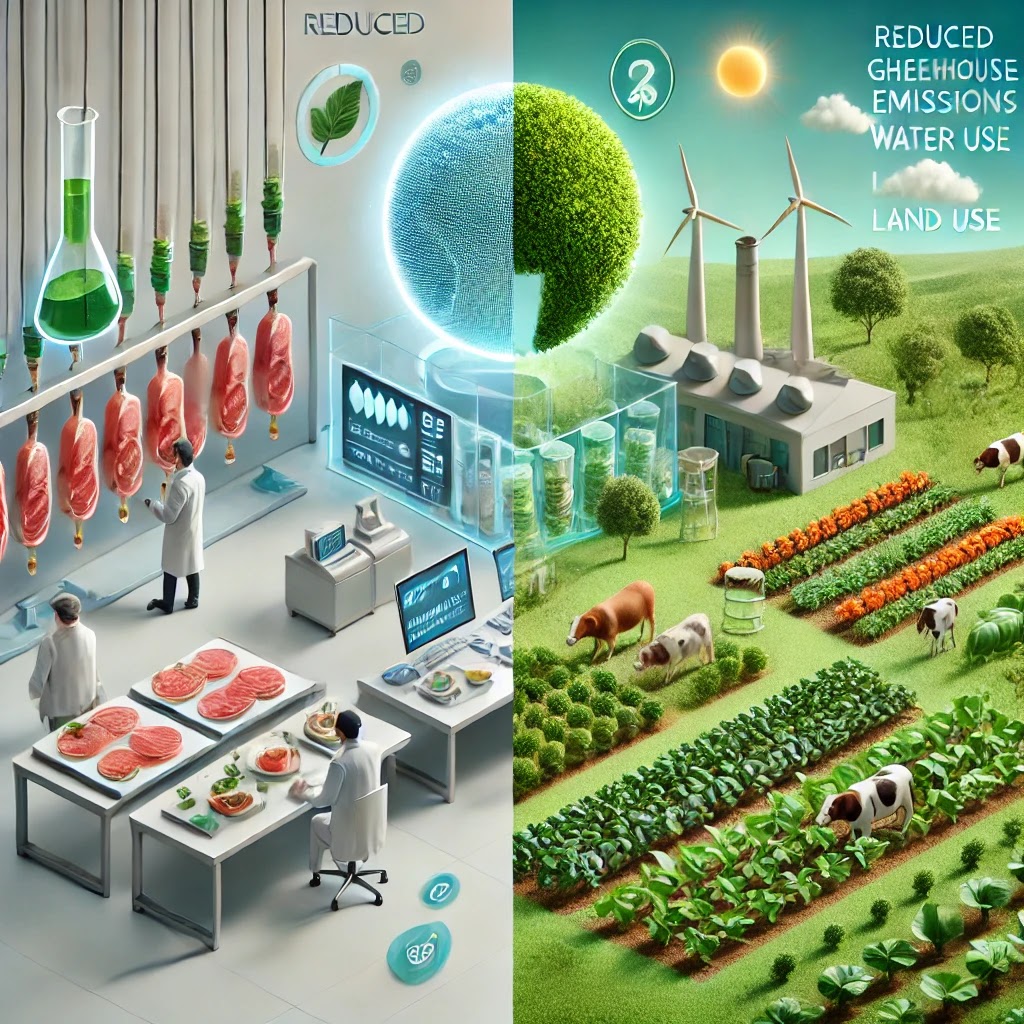The Future of Food: Lab-Grown Meat vs. Plant-Based Alternatives – What Will Dominate? 🌱🍔
In the ever-evolving world of food technology, two contenders are vying for the future of sustainable protein: lab-grown meat and plant-based alternatives. With the global population projected to reach nearly 10 billion by 2050, the pressure is on to find ways to feed people while reducing the environmental impact of traditional meat production. The question on everyone’s mind: Which will dominate the future of food? 🌍
 |
| A split-screen comparison showing lab-grown meat developed in a futuristic laboratory and plant-based meat alternatives made from natural ingredients like soy and vegetables. |
Lab-Grown Meat: The Next Evolution of Protein 🧪🥩
Lab-grown meat (also known as cultured or cell-based meat) is produced by growing animal cells in a controlled environment, essentially “breeding” meat without slaughtering animals. It's real meat, down to its cellular structure, but without the ethical concerns or environmental strain of factory farming.
TweetSustainability 🌿♻️
- Environmental Benefits: Lab-grown meat promises to dramatically reduce greenhouse gas emissions, water usage, and land use compared to traditional livestock farming. A study from the University of Oxford found that cultured meat could reduce agricultural greenhouse emissions by up to 96%!
- Energy Consumption: While lab-grown meat is still energy-intensive, technological advancements may eventually make it more efficient than conventional methods.
Taste and Texture 🍖👅
One of the biggest selling points is that it is actual meat. Unlike plant-based alternatives, lab-grown meat mimics the taste, texture, and appearance of animal meat. Early taste tests have yielded positive results, but there’s room for improvement as the technology matures.
Health Impacts 💊💪
- Customization Potential: Lab-grown meat can be modified to include fewer unhealthy fats, making it a potentially healthier option than traditionally farmed meat. It can also be fortified with vitamins, like B12 and omega-3 fatty acids, making it more nutrient-dense.
Plant-Based Alternatives: Nature’s Answer 🌱🍔
Plant-based meat substitutes, such as those produced by companies like Beyond Meat and Impossible Foods, have taken the world by storm in recent years. Made primarily from pea protein, soy, and wheat, these products are designed to look, cook, and taste like traditional meat.
Sustainability 🍃🌍
- Eco-Friendly Production: Plant-based alternatives require significantly less land, water, and energy than conventional meat. For example, producing an Impossible Burger generates 89% fewer emissions and uses 87% less water than a beef burger.
- Biodiversity: By reducing the need for large-scale livestock farming, plant-based alternatives help preserve biodiversity by preventing deforestation and habitat loss.
Taste and Texture 👅🍔
Modern plant-based meats have made leaps in terms of taste and texture, mimicking the experience of real meat more closely than ever before. However, they still fall short of completely replicating the mouthfeel and juiciness of actual beef or chicken.
Health Impacts 🥗🍽️
- Nutritional Profile: Many plant-based meats are lower in saturated fats and free of cholesterol, which makes them a healthier option for heart health. However, some critics point to their high sodium content and use of additives as potential drawbacks.
- Natural Ingredients: Plant-based options often contain fiber, antioxidants, and phytonutrients, which are beneficial for long-term health and wellness.
Critical Comparison: Lab-Grown Meat vs. Plant-Based Alternatives ⚖️🥩🌱
1. Environmental Impact 🌍🔥
While both lab-grown meat and plant-based alternatives aim to reduce the environmental footprint of food production, plant-based meats currently have the upper hand in terms of energy efficiency and resource use. Lab-grown meat still requires significant energy inputs for production, though advances in technology could close this gap in the future.
2. Taste and Consumer Acceptance 👨👩👧🍽️
Lab-grown meat holds the advantage in terms of replicating the authentic taste and texture of traditional meat. Since it's biologically identical to real meat, meat-eaters may find it more appealing. Plant-based meats, while tasty, still have some catching up to do in terms of fully mimicking the experience of eating meat.
3. Scalability and Cost 💸📈
Currently, plant-based meat is far more scalable and cost-effective. Brands like Beyond and Impossible have already achieved mainstream success and are available in grocery stores and restaurants worldwide. On the other hand, lab-grown meat is still in the R&D phase with high production costs, though experts predict that prices will drop significantly as the technology matures.
4. Health Impacts 🧠🍽️
Both lab-grown and plant-based meats offer potential health benefits over traditional meat. However, lab-grown meat has the edge in customizability, offering the possibility to engineer healthier versions of meat with less fat and more nutrients. Plant-based alternatives, while lower in cholesterol and rich in fiber, often rely on processed ingredients, which may not appeal to health-conscious consumers.
Which Will Dominate? Predictions for the Future 🔮🌱🥩
The battle between lab-grown meat and plant-based alternatives is just beginning, and both have the potential to play a significant role in the future of food. However, the ultimate winner will depend on several factors:
- Consumer Perception: Will people embrace lab-grown meat as real meat, or will they prefer the familiarity of plants? Cultural acceptance will be crucial for lab-grown meat to succeed on a large scale.
- Cost and Availability: As lab-grown meat becomes more affordable, it could rival plant-based alternatives in terms of cost, making it a viable competitor.
- Sustainability Goals: With increasing awareness of climate change and environmental degradation, consumers are likely to opt for whichever alternative can provide the lowest carbon footprint.
For now, plant-based alternatives are leading the charge, but as lab-grown meat becomes more accessible, it may eventually close the gap and revolutionize the way we consume protein.
Conclusion: A Combined Future? 🌱+🥩
While it’s tempting to pit lab-grown meat against plant-based alternatives, the future might not be a zero-sum game. Both technologies could coexist, offering consumers a diverse range of sustainable protein options. Flexitarians and environmentally conscious eaters could incorporate both into their diets, reducing their reliance on traditional meat without sacrificing taste or nutrition.
The question isn’t just which will dominate, but rather, how will these innovations shape the future of food together? 🌎🍽️
Final Thought: The Meat of Tomorrow is Here – Are You Ready to Dig In? 🍴



.gif)





0 Comments
Please do not enter spam links in the comment box.